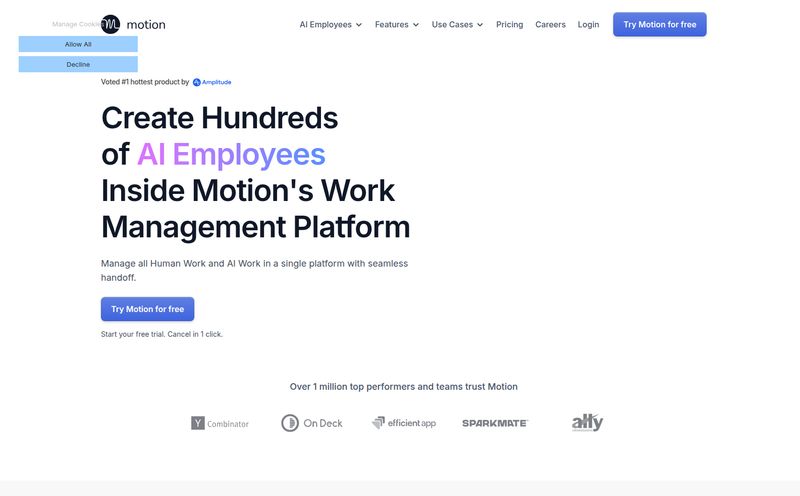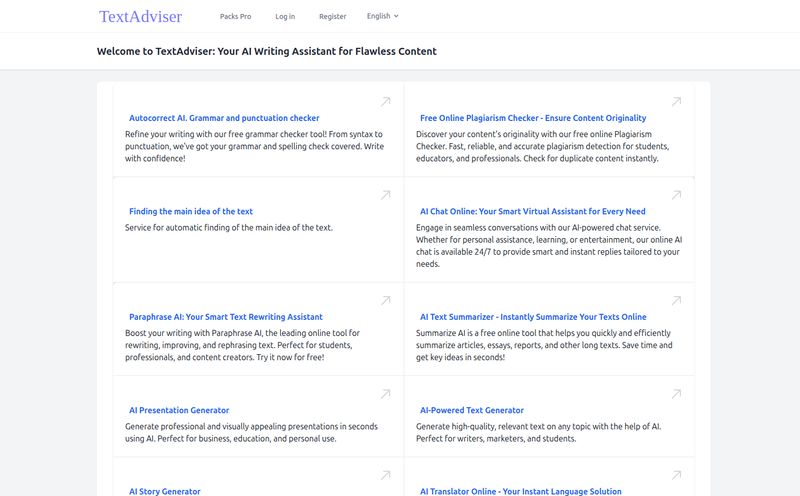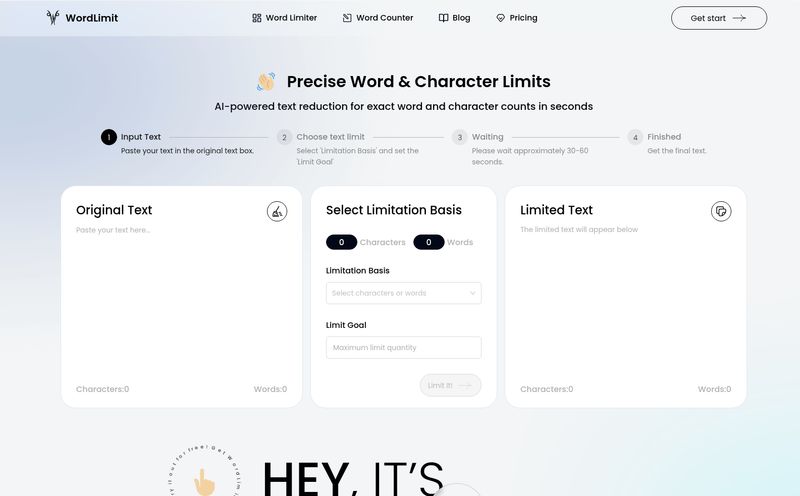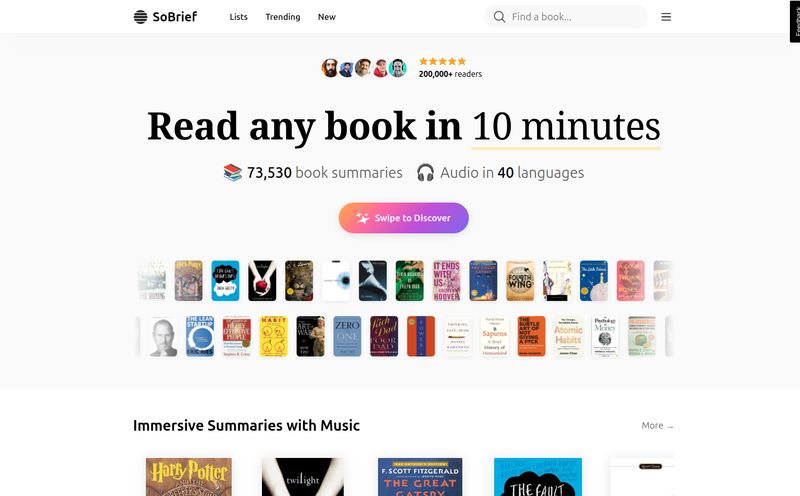If you’re in marketing, SEO, or just a deeply curious person, your email inbox probably looks a lot like mine did: a battlefield. A constant, screaming torrent of ‘must-read’ articles from Substack, ‘unmissable’ trend reports from industry leaders, and ‘urgent’ updates that I had willingly, foolishly, signed up for in moments of aspirational weakness.
Every morning, it was the same ritual. Wade through the digital sludge, promising myself “I’ll read that later.” Spoiler alert: “later” never comes. The newsletters pile up, creating a sense of anxiety and FOMO. You're afraid to miss the one golden nugget of information, but you're drowning in the noise. It’s a classic case of information overload, and frankly, it was killing my productivity.
I’ve tried everything. Complicated filter rules, dedicated email clients, the ‘unsubscribe’ button of shame. Nothing stuck. Then, I stumbled upon a tool called LaterOn. The promise? To aggregate, schedule, and even summarize my newsletters with AI. Skeptical but desperate, I gave it a shot. And I'm not gonna lie, it's been a bit of a game-changer.
So, What Exactly is LaterOn?
Think of LaterOn not as a filter, but as a friendly bouncer for your inbox. It gives you a special, unique email address: `[email protected]`. This is the genius part. Instead of giving your real email to every blog, publication, and Substack writer you find interesting, you give them your LaterOn address.
LaterOn then catches all those emails for you. It holds them in a neat, tidy queue, far away from your primary inbox where, you know, important client emails live. Then, based on your preference, it bundles them all up and sends you a single digest. Once a day? Once a week? Once a month? You choose. It’s like creating your own personalized magazine compiled from all your favorite sources, delivered on your schedule. No more constant pings. No more clutter.
How It Solved My Newsletter Nightmare
As someone who needs to stay on top of Google algorithm updates, CPC fluctuations, and the latest content marketing strategies, my newsletter list is… extensive. And by extensive, I mean borderline unmanageable. I had subscriptions to everything from the big players like Search Engine Land to niche Substack writers who drop incredible insights.
The result was that I was missing stuff. Important stuff. An email about a core update would get buried under a 20% off sale. A brilliant case study would be lost in a sea of unread notifications. LaterOn put a stop to that. Now, every Friday afternoon, I get my “Weekly Digest” from LaterOn. I grab a coffee, sit down, and I have one, just one, email to go through with all my professional reading for the week. It’s blissful.
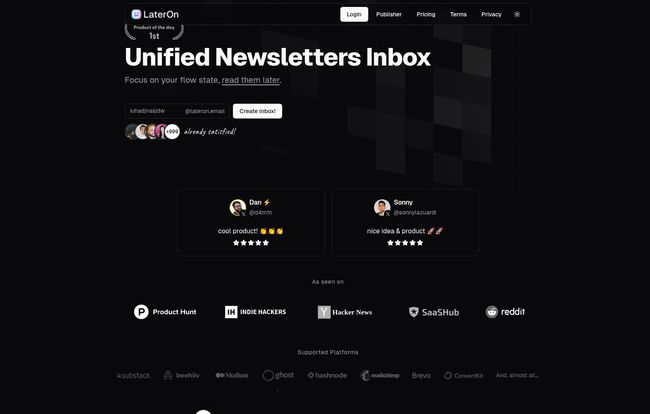
Visit LaterOn
The Standout Features That Genuinely Help
A lot of SaaS tools are packed with features that look cool on the landing page but you never actually use. LaterOn keeps it pretty focused, which I appreciate. Here’s what’s moved the needle for me.
The AI Summaries: A Genuine Time-Saver?
This was the feature I was most skeptical about. An AI that reads my newsletters and gives me the Cliff Notes? Sounds too good to be true. For the most part, it works surprisingly well. The summaries are concise and usually capture the main gist of the article, letting you quickly decide if you want to click through and read the whole thing. It's perfect for those long, rambling think-pieces where you just need the core argument. Now, is it perfect? No. Sometimes nuance gets lost in translation, which I’ll touch on later.
Your Personal Reading Schedule
This is, without a doubt, the most impactful feature. The ability to switch from a constant drip-feed of information to a scheduled, weekly batch is a mental game-changer. It puts you back in control of your information diet. Instead of being reactive to every email that lands, you proactively set aside time to consume content. For anyone trying to practice deep work or just reduce digital distractions, this is huge.
The “Ask Anything” AI Assistant
This is a newer feature and it's pretty neat. You can essentially ‘chat’ with your newsletters. For example, I can ask it, “Did any of my newsletters mention the latest Google helpful content update?” and it will scan the content it has received and pull out relevant snippets. It's like having a personal research assistant for your own subscription library. The number of questions you can ask is tied to your subscription tier, so it's more of a power-user feature, but a very cool one.
Let's Talk About the Price Tag
Alright, the all-important question: what’s this going to cost you? LaterOn has a tiered pricing model that seems pretty fair for the value it provides. You can find the full details on their pricing page, but here’s a quick rundown:
| Plan | Price | Who It's For |
|---|---|---|
| Lite | $8 / month | The casual reader who wants to declutter their inbox. You get unlimited incoming emails but are limited to 50 AI summaries a month. |
| Starter | $16 / month | This is the sweet spot for most professionals. You get a hefty 480 summaries and 1,440 chats with the AI assistant. |
| Premium | $22 / month | The power user. For info-junkies and content creators who need over 1,000 summaries, tons of AI chats, and priority support. |
In my opinion, the Starter plan offers the best bang for your buck if you're a professional who subscribes to a decent number of newsletters.
The Not-So-Perfect Bits: An Honest Critique
No tool is perfect, and it would be dishonest to pretend LaterOn is. Here are a couple of things to keep in mind.
First, the AI summaries. While great 90% of the time, they are still AI summaries. If the newsletter is highly technical, deeply nuanced, or written with a very specific authorial voice, the summary might miss the mark. I still find myself clicking through to the original for my absolute most-trusted sources. You have to treat the summary as a preview, not a replacement.
Second, the setup. The magic of LaterOn requires you to use the @lateron.email address. For new subscriptions, this is easy. But for the dozens (or hundreds) of newsletters you're already subscribed to? You have to go and manually change your email address on each one. It's a bit of a pain upfront, I won't sugarcoat it. But it's a one-time task for a long-term gain in sanity.
Is LaterOn Right For You?
So, who should jump on this? If you're a marketer, founder, researcher, writer, or just an insatiably curious person who feels perpetually behind on your reading, then yes. Absolutely. The mental space it frees up is worth the price of a couple of coffees a month.
Who should probably skip it? If you only subscribe to two or three newsletters and enjoy reading them as they arrive, this is overkill. You don't need a tool to solve a problem you don’t have. Also, if you are someone who needs to read every single word of a newsletter in its original, pixel-perfect formatting the moment it’s released, the digest model might feel restrictive.
My Final Verdict: A Worthy Addition to the Toolbox
After a few months of use, LaterOn has earned a permanent spot in my workflow. It took a problem that was a constant, low-level source of stress and just... solved it. My main inbox is clean, I don't miss important articles anymore, and I feel more in control of my time and attention.
It’s not a magic bullet, but it's a powerful and intelligently designed tool that addresses a very modern problem. It gives you the benefit of all that amazing information out there, without the penalty of a chaotic inbox. And in today's attention economy, that’s a pretty incredible thing.
Frequently Asked Questions
- How does LaterOn actually work?
- It's simple! You get a unique `@lateron.email` address. You use this address to sign up for newsletters. LaterOn collects them and sends you a single, bundled email (a digest) on a schedule you choose—daily, weekly, or monthly.
- Can I use it with any newsletter service like Substack or beehiiv?
- Yes. Since it just works with email, it's platform-agnostic. It supports Substack, beehiiv, Convertkit, Mailchimp, and pretty much any service that sends emails.
- Is there a mobile app for LaterOn?
- There isn't a dedicated native app at the moment, but the website is designed to be fully mobile-friendly. You can easily manage your account and read your digests from your phone's browser.
- What happens if I go over my monthly AI summary limit?
- Your newsletters will still be collected and delivered in your digest. They just won't have the AI-generated summary attached. You'll simply see the title and a snippet, and you can click to read the full version.
- Is it difficult to switch all my existing subscriptions over?
- It does take some upfront effort. You'll need to visit each newsletter's subscription management page and update your email to the new LaterOn address. It might take 30-60 minutes, but you only have to do it once.
- How reliable is the AI summary really?
- It's very good for getting the main points and deciding if a full read is worthwhile. However, for highly nuanced or technical content, it's always best to view it as a helpful preview rather than a complete substitute for the original article.
